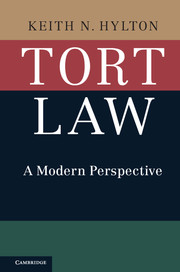Book contents
- Frontmatter
- Contents
- 1 Introduction
- 2 Policy and Tort Law
- 3 Evolution of Tort Law
- 4 Intentional Torts
- 5 Theoretical Foundations of Strict Liability
- 6 The Reasonable Person
- 7 Customs, Statutes, and the Reasonable Person
- 8 Inferring Negligence
- 9 Contributory Negligence and Assumption of Risk
- 10 Contributory Negligence, Comparative Negligence, and Incentives for Care
- 11 Joint and Several Liability, and Vicarious Liability
- 12 Factual Causation
- 13 Proximate Cause
- 14 Duty to Rescue and Special Relationships
- 15 Strict Liability: Conversion, Abnormally Dangerous Activities, and Nuisance
- 16 Defamation
- 17 Products Liability
- 18 Damages
- Index
3 - Evolution of Tort Law
Published online by Cambridge University Press: 05 June 2016
- Frontmatter
- Contents
- 1 Introduction
- 2 Policy and Tort Law
- 3 Evolution of Tort Law
- 4 Intentional Torts
- 5 Theoretical Foundations of Strict Liability
- 6 The Reasonable Person
- 7 Customs, Statutes, and the Reasonable Person
- 8 Inferring Negligence
- 9 Contributory Negligence and Assumption of Risk
- 10 Contributory Negligence, Comparative Negligence, and Incentives for Care
- 11 Joint and Several Liability, and Vicarious Liability
- 12 Factual Causation
- 13 Proximate Cause
- 14 Duty to Rescue and Special Relationships
- 15 Strict Liability: Conversion, Abnormally Dangerous Activities, and Nuisance
- 16 Defamation
- 17 Products Liability
- 18 Damages
- Index
Summary
The previous chapter introduced the basic concepts of strict liability and negligence, and examined incentives under the two standards. But these tort standards have not always been available to plaintiffs. The tort system began with a very narrow scope of application, basically restricted to giving victims of crime a forum in which to seek compensation from their injurers. As time passed, tort law expanded to permit victims of less serious infringements, such as accidents on the roads, a means of seeking redress in the courts. This chapter examines how this change came about.
The short answer is that the change occurred through an evolutionary process. As the tort system expanded, the old rules that worked reasonably well under its early narrow scope began to generate unintended consequences and poor results. This led, in turn, to pressure to reform the tort system within the common law process, through modifications of tort doctrine, which is what occurred over the centuries. This chapter examines this process of evolution from the earliest to the modern tort cases.
Along the way this chapter explores one long-standing controversy in tort theory: whether the underlying norm of ancient tort law was strict liability or liability based on fault (negligence). This question was addressed by Holmes in his book on the common law.
Holmes argued that the fault principle was evident in the earliest tort cases, and distinguished his position from two alternatives: that an individual always acts at his peril (strict liability) and that tort liability results from a failure to comply with moral norms (ethical liability). The strict liability theory, a prominent account of tort liability at least since the mid–nineteenth century, has received additional support from the modern thesis that courts adopted the fault principle near the end of the Industrial Revolution to subsidize emerging industries. The ethical theory has also been a prominent account, but it has not featured much in the historical controversy over the nature of ancient tort liability. Hence, in this chapter I will explore the broader distinction between strict liability and fault as foundational principles in tort law – not the more fine-grained distinction between objectivist and ethical theories of fault.
- Type
- Chapter
- Information
- Tort LawA Modern Perspective, pp. 32 - 47Publisher: Cambridge University PressPrint publication year: 2016
- 1
- Cited by

